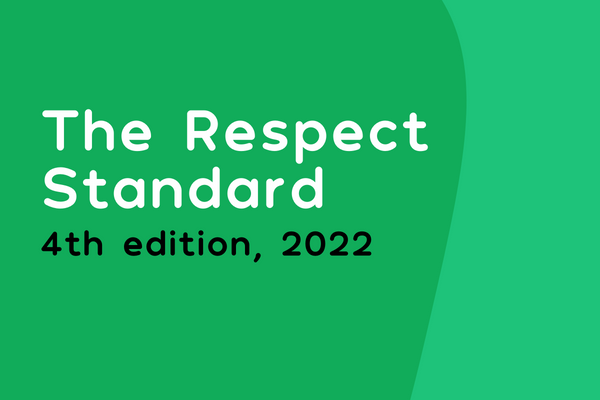We’ve launched an updated and refined edition of the Respect Standard, our flagship quality assurance framework for work with perpetrators of domestic abuse. But what is the Standard, and why is it important?
What is the Respect Standard?
Published for the first time 14 years ago, the Respect Standard is a set of requirements for work with perpetrators of domestic violence and abuse. It sits at the heart of our rigorous accreditation process, which assesses domestic abuse perpetrator interventions for safety and effectiveness.
The influence of the Standard extends beyond assessing services. It serves as a definitive guide for commissioners, the people who make decisions about what services money is spent on and which organisations should be funded to deliver the work.
Often, commissioners won’t be experts in perpetrator interventions, so they use the Respect Standard and accreditation process to see which organisations are delivering safe and effective work.
How does the Respect Standard keep survivors safe?
The primary focus of a perpetrator intervention should be enhancing the safety and freedom of survivors (including children), a principle that has always been at the core of the Respect Standard.
In practice, this means that all perpetrator interventions meeting the Standard, regardless of their structure, must include specialist, separate, parallel provision. This can be provided in-house by the same provider who is running the perpetrator intervention, or it can be provided externally by a separate survivor service. This expert provision ensures survivors have the support and information they need, and that the organisation can monitor the perpetrator’s progress and any emerging risks.
In this edition of the Standard, we have split survivor support into its own section, ensuring commissioners and services give it the priority and focus it needs.
Does the Respect Standard assess how services support children?
Yes – all types of services must show how they focus on the needs and safety of the children and young people connected to its service users.
What kind of interventions does the Respect Standard apply to?
This new edition of the Respect Standard covers two types of intervention.
Structured and sequential interventions
The first type is known as “Structured and sequential interventions”, which can include behaviour-change interventions and early response, awareness-raising interventions.
Behaviour-change interventions are aimed at perpetrators who are willing to engage and are relatively stable in terms of mental health, housing, substance misuse, and other factors that may impact on their capacity to change. They aim to help perpetrators develop their motivation to change, and understand the impacts of abuse on their partner or ex-partner.
Early response or awareness-raising interventions can be delivered as a standalone intervention or as an add-on before a behaviour-change intervention. They’re aimed at perpetrators who are concerned about their behaviour, are willing to make a change and do not have an outstanding civil or criminal matter relating to their behaviour. They aim to raise perpetrators’ awareness of their abusive/violence/coercive behaviours and the impact on their (ex) partners.
Examples of structured and sequential interventions are Make a Change and CLEAR (part of the Change that Lasts model).
Intensive Case Management
The second type of intervention is known as “Intensive Case Management”. The primary focus of these interventions is to help manage the risk posed by those whose behaviour is very harmful, as well as people who perpetrate abuse repeatedly with multiple victims. The main function of this model is to manage risk, safeguard survivors including children, and create increased accountability. This is achieved through rigorous assessment and identification of risk and need, and, where appropriate, direct engagement with the perpetrator.
An example of an Intensive Case Management intervention is Drive.
How is the Respect Standard different from the Home Office's Standards for domestic abuse perpetrator interventions?
The Home Office's Standards have been introduced to set out a base level of what services need to be achieving in order to be commissioned. The Respect Standard is different for a variety of reasons:
- As the Respect Standard is the basis for a wider, rigorous accreditation process, it is used to assess whether organisations are safe and effective. Because of this robust process, survivors, commissioners and service users can be confident that the service is doing high quality work with perpetrators. The Home Office Standards do not have an accompanying assessment and accreditation process.
- The Respect Standard is regularly reviewed and refined by experts to reflect best practice, and drive improvement and innovation.
- The Respect Standard is a well-established kitemark of quality for funders, so often features as a funding criterion for perpetrator services applying for funding from Police and Crime Commissioners.
- Respect’s accreditation process gives services the chance to reflect on their own practice, giving them confidence that they are delivering a quality service and enabling them to make changes that benefit survivors and service users.
- The Respect Standard commits services to resolve service users' complaints in a fair and transparent way, and in cases where services users are unhappy with the response, Respect takes on these complaints. Respect-accredited services must cooperate fully with Respect staff, allowing them to investigate complaints and complying with Respect's recommendations, in cases where complaints are upheld.





